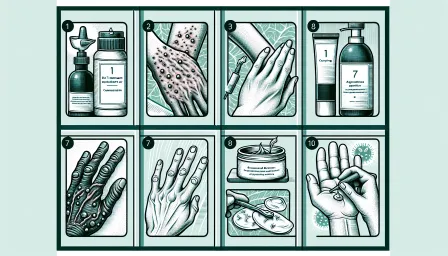The Ultimate Dry Acne Prone Skin Routine: Steps for a Clearer Complexion

Discover the ultimate dry acne prone skin routine for a clearer complexion. Learn effective steps, products, and tips to manage and treat both dryness and acne.
Having dry acne-prone skin can be incredibly challenging. Balancing the need to hydrate while managing breakouts seems like an impossible task. However, with a well-structured skincare routine designed specifically for dry acne-prone skin, you can achieve a clearer and healthier complexion. This comprehensive guide will provide you with actionable steps, recommended products, and valuable tips. Let's dive in!
Understanding Dry Acne-Prone Skin
Before creating a routine, it's crucial to understand the unique characteristics of dry acne-prone skin. This skin type exhibits both flakiness and breakouts, making it difficult to determine which issue to address first. Typically, dry acne-prone skin lacks moisture, leading to overcompensation by oil glands, which in turn causes clogged pores and acne.
Essential Steps for a Dry Acne Prone Skin Routine
1. Gentle Cleansing
Start your routine with a gentle, hydrating cleanser. Look for non-comedogenic formulations that won't strip your skin of essential oils. Ingredients like hyaluronic acid are beneficial for maintaining moisture balance. Avoid sulfates and harsh detergents.
2. Exfoliation
Exfoliation is key to removing dead skin cells that can clog pores. Opt for gentle chemical exfoliants like alpha-hydroxy acids (AHAs) or beta-hydroxy acids (BHAs) rather than physical scrubs, which can be too abrasive for dry skin.
3. Hydrating Toner
Toners help restore skin's pH balance and provide an additional layer of hydration. Choose a toner with soothing and hydrating components like glycerin, aloe vera, or chamomile extract.
4. Serums with Active Ingredients
Serums are potent in treating specific skin concerns. For dry acne-prone skin, consider serums with ingredients like niacinamide, which helps regulate sebum production and reduce inflammation, and hyaluronic acid for hydration.
5. Moisturizing
Moisturizing is a crucial step. Look for non-comedogenic moisturizers that are both hydrating and soothing. Ceramides, fatty acids, and plant oils can fortify the skin barrier while preventing moisture loss.
6. Spot Treatments
Use targeted spot treatments for active breakouts. Ingredients like benzoyl peroxide and salicylic acid are effective but should be used sparingly to prevent drying out the surrounding skin.
7. Sun Protection
Daily sun protection is non-negotiable. Choose a broad-spectrum sunscreen with at least SPF 30. Opt for formulations that are lightweight and non-comedogenic.
Recommended Products for Each Step
Gentle Cleansers
- CeraVe Hydrating Cleanser
- La Roche-Posay Toleriane Hydrating Gentle Cleanser
Chemical Exfoliants
- Paula's Choice Skin Perfecting 2% BHA Liquid Exfoliant
- The Ordinary Glycolic Acid 7% Toning Solution
Hydrating Toners
- KLAIRS Supple Preparation Unscented Toner
- Thayers Alcohol-Free Rose Petal Witch Hazel Toner
Serums
- The Ordinary Niacinamide 10% + Zinc 1%
- Vichy Mineral 89 Hyaluronic Acid Serum
Moisturizers
- Neutrogena Hydro Boost Water Gel
- First Aid Beauty Ultra Repair Cream
Spot Treatments
- Clean & Clear Advantage Acne Spot Treatment
- Mario Badescu Drying Lotion
Sunscreens
- EltaMD UV Clear Broad-Spectrum SPF 46
- La Roche-Posay Anthelios Melt-in Milk Sunscreen SPF 60
Additional Tips for Managing Dry Acne-Prone Skin
Consistency and patience are key when caring for dry acne-prone skin. Here are additional tips to enhance your routine:
- Stay hydrated by drinking plenty of water.
- Avoid excessive use of acne treatments to prevent over-drying.
- Incorporate a humidifier in your living space to maintain air moisture levels.
- Limit the use of makeup and ensure your cosmetics are non-comedogenic.
- Avoid hot showers, which can strip your skin of natural oils.
Common Mistakes to Avoid
Even with the right products, certain practices can counteract your efforts. Avoid these common mistakes:
- Over-exfoliating, which can compromise the skin barrier.
- Skipping moisturizer, assuming it will make acne worse.
- Using too many active ingredients at once, leading to irritation.
- Ignoring sunscreen due to fear of clogging pores.
Consulting a Dermatologist
If you find that over-the-counter products aren’t sufficient, consider consulting a dermatologist. They can provide tailored advice and may prescribe medications or treatments that specifically address both dryness and acne.
Conclusion
Caring for dry acne-prone skin requires a balanced approach to both hydrate and treat breakouts. By following the outlined steps and incorporating recommended products, you can create an effective routine that leads to a healthier, clearer complexion. Always remember, consistency, patience, and understanding your skin's unique needs are key to success.



























